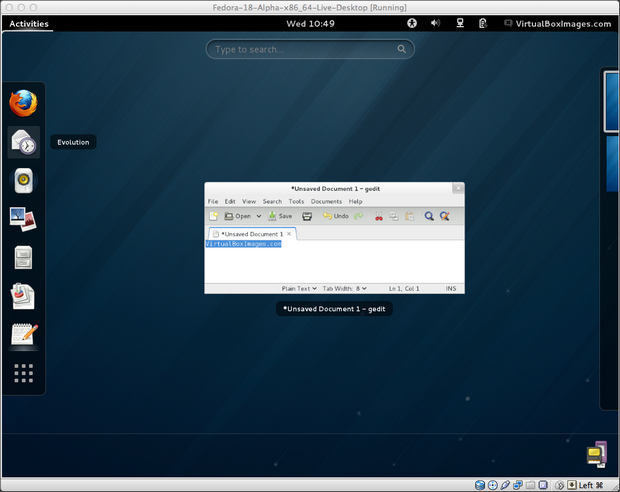 De Linux-distributie Fedora is aangeland bij versie 18. Fedora is de niet-commerciële opvolger van Red Hat Linux, dat zich sinds 2003 als Red Hat Enterprise Linux op de zakelijke markt richt. Fedora wordt standaard met de Gnome-desktopomgeving geleverd, maar er zijn ook versies met MATE, Cinnamon, KDE en Xfce beschikbaar. De meest in het oog springende verbeteringen die zijn aangebracht in versie 18 'Spherical Cow' zijn hieronder op een rijtje gezet.
De Linux-distributie Fedora is aangeland bij versie 18. Fedora is de niet-commerciële opvolger van Red Hat Linux, dat zich sinds 2003 als Red Hat Enterprise Linux op de zakelijke markt richt. Fedora wordt standaard met de Gnome-desktopomgeving geleverd, maar er zijn ook versies met MATE, Cinnamon, KDE en Xfce beschikbaar. De meest in het oog springende verbeteringen die zijn aangebracht in versie 18 'Spherical Cow' zijn hieronder op een rijtje gezet.
For desktop users
Moooove over, stale desktops. We've got a small herd of choices udderly suited to your preferences.Regardless of your desktop choice, Fedora 18 offers...
- GNOME 3.6 The newest version of the GNOME desktop provides an enhanced Messaging Tray, support for Microsoft Exchange and Skydrive, and many more new features. For more information, visit the GNOME release notes.
- Cinnamon Fedora users now have the option of using Cinnamon, an advanced desktop environment based on GNOME 3. Cinnamon takes advantage of advanced features provided by the GNOME backend while providing users with a more traditional desktop experience.
- MATE Desktop The MATE desktop provides users with a classic GNOME 2.x style user interface. This desktop is perfect for users who have been running GNOME Classic or other window managers like XFCE as an alternative to GNOME 3.
- KDE Plasma Workspaces 4.9 KDE Plasma Workspaces has been updated with many new features and improved stability and performance, including updates to the Dolphin File Manager, Konsole, and KWin Window manager.
- Xfce 4.10 The lightweight and easy-to-use Xfce desktop has been updated to the 4.10 version with many bug fixes and enhancements, including a new MIME type editor, a reworked xfce4-run dialog, improved mouse settings, tabs in the Thunar file manager, and options to tile windows in xfwm4. Through all of these and more, Xfce continues to improve without getting in your way.
For developers
- Improved storage management SSM (System Storage Manager) is an easy-to-use command-line interface tool that presents a unified view of storage management tools. Devices, storage pools, volumes, and snapshots can now be managed with one tool, with the same syntax for managing all of your storage. (It's great for systems administrators, too!)
For developers there are all sorts of moo-tivating goodies:For systems administrators
- Fresh versions of programming languages Using Perl, Rails, or Python? All three of these languages are updated in Fedora 18. We've got Rails 3.2, Python 3.3, and Perl 5.16 fresh off the farm.
- Clojure Clojure gets more love with the addition of tooling packages, including the Leinengen build tool, as well as Clojure libraries and frameworks, including Korma and Noir.
- DragonEgg connects GCC and LLVM DragonEgg is a plugin for the GCC compilers to allow use of the LLVM optimization and code-generation framework. DragonEgg provides software developers with more optimization and code-generation options for use with the GCC compilers. DragonEgg also allows GCC to be used for cross-compilation to target architectures supported by LLVM without requiring any special cross-compilation compiler packages. Fedora continues to develop and use GCC as the standard default compiler.
Keep track of your infrastructure herds with these new features:For clouds and virtualization
- Offline system updates Systems can now be updated offline, allowing for a more stable update of critical system components. This functionality is only integrated with GNOME Desktop Environment in this release but uses the distribution neutral PackageKit and systemd API's and hence can be made available for other desktop environments as well based on the interest from upstream developers.
- Storage enhancements StorageManagement is a collection of tools and libraries for managing storage area networks (SAN) and network attached storage (NAS).
- Samba 4 This popular suite of tools has long provided file- and print-sharing services in heterogeneous operating system environments. The long-awaited Samba 4 introduces the first free and open source implementation of Active Directory protocols and includes a new scripting interface, allowing Python programs to interface to Samba's internals.
- Riak A fault-tolerant key-value store, Riak provides easy operations and predictable scaling as a NoSQL database.
Do you spend your days grazing gazing into the clouds? Here's just a taste of some of the cloud and virt features you'll see in Fedora 18:And that's only the beginning. For a more complete list with details of all the new features in Fedora 18, steer over here.
- Eucalyptus Eucalyptus makes its first appearance in Fedora, with their 3.2 release included in F18. This platform for on-premise (private) Infrastructure-as-a-Service clouds uses existing infrastructure to create scalable and secure AWS-compatible cloud resources for compute, network, and storage.
- OpenStack With the Folsom release in Fedora 18, OpenStack continues to have the newest releases in Fedora. This open source cloud computing platform enables users to deploy their own cloud infrastructures for private or public cloud deployments. Heat, an incubated OpenStack project, is also available in F18, providing an API that enables the orchestration of cloud applications using file or web based templates.
- oVirt Engine The management application for the oVirt virtualization platform, oVirt Engine, is updated to the newest version, 3.1. This release includes extensive new features, including support for live snapshots, cloning virtual machines from snapshots, quotas, and more.
- Suspend and resume support for virt guests Virtual machines get love with this feature, enabling the ability to suspend and resume guests, with the close of a laptop lid or menu option or via the command line.


:fill(white):strip_exif()/i/2007026030.jpeg?f=thumbmedium)